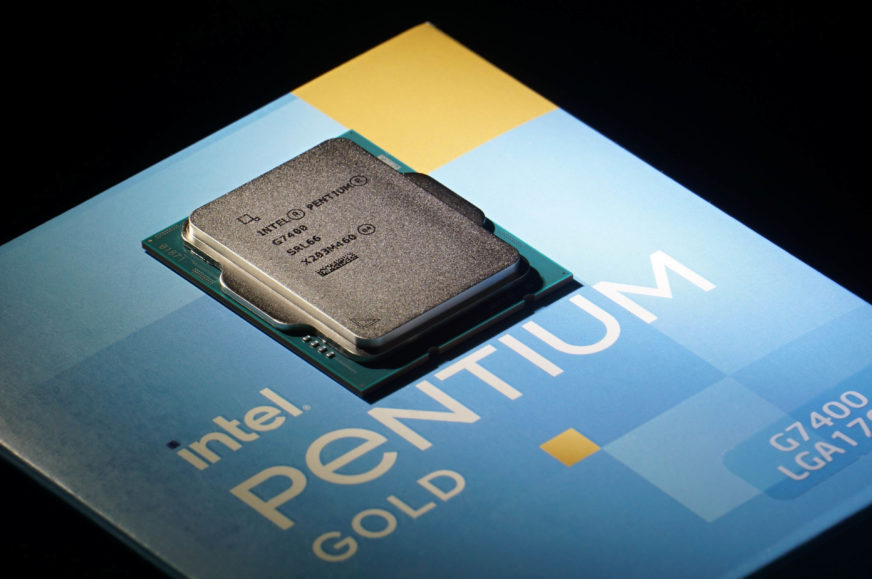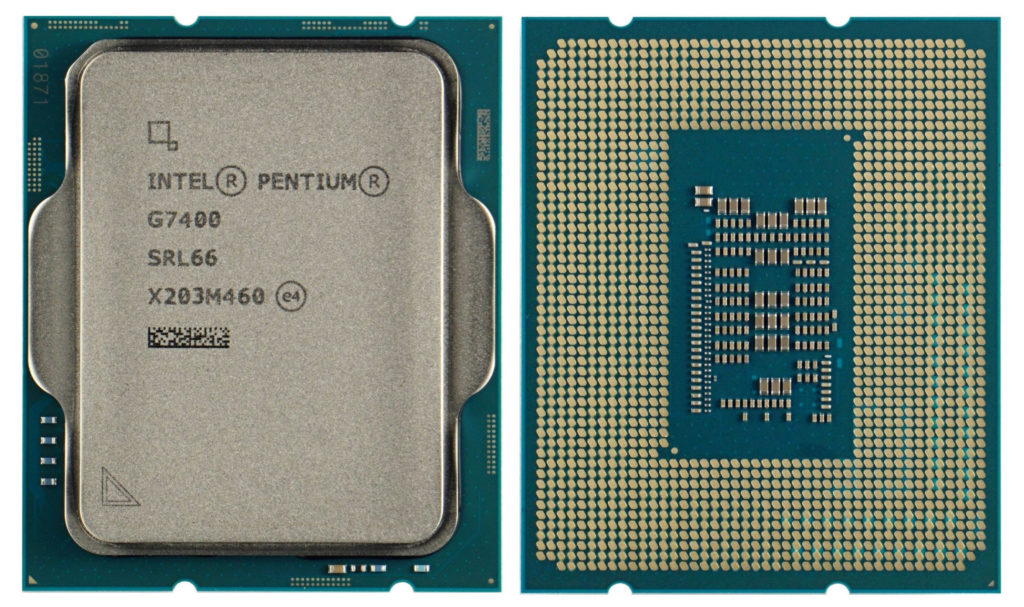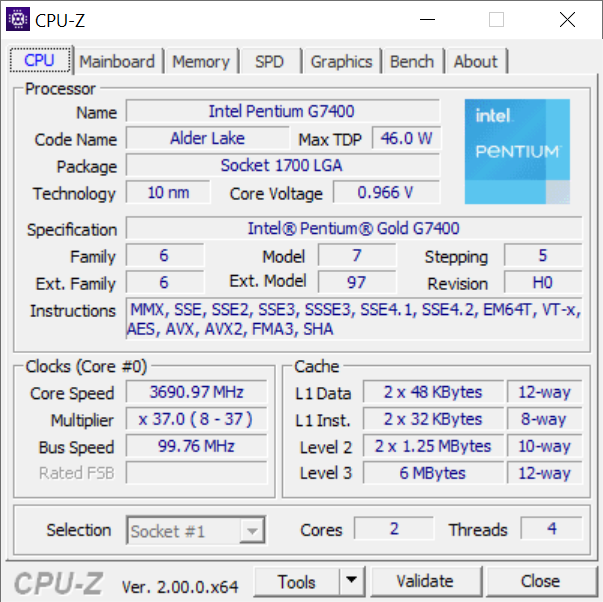Intel Pentium G7400 in detail
From the top, we gradually worked our way down to the class of the iconic Pentium. Its design is quite conservative by today’s standards. The performance of the dual-core processor is at the limit, which begins to complicate the actual execution of the tests. One of the biggest appeals is the low power draw, but that may not be worth much if your processor can’t handle your demands in real time. Or can it?
Intel Pentium G7400 v detailoch
The processor is built on two cores of the Golden Cove architecture, the large – “powerful” ones. Compared to the cheaper Celeron G6900, the Pentium G7400 has 2 MB more L3 cache (6 MB), HyperThreading (it is a four-thread processor) and the base frequency is also higher, by 400 MHz. Meanwhile, the Pentium G7400’s 3.7 GHz runs in both single-threaded and multi-threaded workloads. This processor does not support any form of Turbo Boost.
The two Golden Cove cores are on a natively 6-core chip with a total area of roughly 160 mm². So these are not the worst quality large chips, which physically have eight P and E cores. The chip is soldered to the heat spreader, which means good heat transfer and eventual quiet operation even with simple low-profile top-flow coolers. This is important for small PCs built on Thin Mini-ITX boards, for example, or for various embedded systems with significantly limited space.
The claimed TDP is 46 W, 12 W lower than the Core i3-12100(F). After capping the Core i3 to Intel’s recommended limits (i.e. PL2 at 58 W), the Pentium could be more efficient as well. This in applications that use two cores, where the G7400 may benefit from higher frequencies. Also, the Pentium has a dual controller, so in addition to DDR5 memory, it also supports DDR4, which makes considerably more sense for the lower price. For this reason, we also tested the processor on a platform with DDR4 memory.
The Pentium G7400 also has an active graphics core – UHD 710 with 128 shaders, 8 texturing and rasterization units. Supported video output via HDMI is 4096×2160 px at 60 Hz. Even though the HDMI 2.1 standard is mentioned in the specs, beware of one thing. The HDMI consortium has rebranded the original HDMI 2.0 standard to HDMI 2.1 (similar to what happened with, for example, UDB 3.0 being renamed to USB 3.1 gen. 1 and then even to USB 3.2 gen. 1). It’s admittedly very confusing, but unfortunately the HDMI 2.1 designation no longer means that the graphics support the capabilities that were originally associated with HDMI (such as support for higher resolutions than 4K or new features).
The package also includes Intel’s new Laminar RS1 cooler. It will be covered in detailed tests later in a separate article over the next week.
| Manufacturer | Intel | Intel | |
| Line | Pentium | Core i3 | |
| SKU | G7400 | 12100F | |
| Codename | Alder Lake | Alder Lake | |
| CPU microarchitecture | Golden Cove (P) | Golden Cove (P) | |
| Manufacturing node | 7 nm | 7 nm | |
| Socket | LGA 1700 | LGA 1700 | |
| Launch date | 01/04/2022 | 01/04/2022 | |
| Launch price | 64 USD | 97 USD | |
| Core count | 2 | 4 | |
| Thread count | 4 | 8 | |
| Base frequency | 3.7 GHz (P) | 3.3 GHz (P) | |
| Max. Boost (1 core) | – | 4.3 GHz (P) | |
| Max. boost (all-core) | – | 4.1 GHz (P) | |
| Typ boostu | – | TB 2.0 | |
| L1i cache | 32 kB/core (P) | 32 kB/core (P) | |
| L1d cache | 48 kB/core (P) | 48 kB/core (P) | |
| L2 cache | 1,25 MB/core (P) | 1,25 MB/core (P) | |
| L3 cache | 1× 6 MB | 1× 12 MB | |
| TDP | 46 W | 58 W | |
| Max. power draw during boost | – | 89 W (PL2) | |
| Overclocking support | No | No | |
| Memory (RAM) support | DDR5-4800/DDR4-3200 | DDR5-4800/DDR4-3200 | |
| Memory channel count | 2× 64 bit | 2× 64 bit | |
| RAM bandwidth | 76,8 GB/s or 51,2 GB/s (DDR4) | 76.8 GB/s or 51.2 GB/s (DDR4) | |
| ECC RAM support | No | No | |
| PCI Express support | 5.0/4.0 | 5.0/4.0 | |
| PCI Express lanes | ×16 (5.0) + ×4 (4.0) | ×16 (5.0) + ×4 (4.0) | |
| Chipset downlink | DMI 4.0 ×8 | DMI 4.0 ×8 | |
| Chipset downlink bandwidth | 16.0 GB/s duplex | 16.0 GB/s duplex | |
| BCLK | 100 MHz | 100 MHz | |
| Die size | ~160 mm² | ~160 mm² | |
| Transistor count | ? bn. | ? bn. | |
| TIM used under IHS | Solder | Solder | |
| Boxed cooler in package | Intel Laminar RS1 | Intel Laminar RM1 | |
| Instruction set extensions | SSE4.2, AVX2, FMA, SHA, VNNI (256-bit), GNA 3.0, VAES (256-bit) | SSE4.2, AVX2, FMA, SHA, VNNI (256-bit), GNA 2.0, VAES (256-bit) | |
| Virtualization | VT-x, VT-d, EPT | VT-x, VT-d, EPT | |
| Integrated GPU | UHD 710 | N/A | |
| GPU architecture | Xe LP (Gen. 12) | – | |
| GPU: shader count | 128 | – | |
| GPU: TMU count | 8 | – | |
| GPU: ROP count | 8 | – | |
| GPU frequency | 350–1350 MHz | – | |
| Display outputs | DP 1.4a, HDMI 2.1 * | – | |
| Max. resolution | 4096 × 2160 px (60 Hz) | – | |
| HW video decode | HEVC, VP9 | – | |
| HW video encode | AV1, HEVC, VP9 | – |
* Don’t be confused by the HDMI 2.1 designation, the maximum supported resolution is 4096×2160 px at 60 Hz refresh rate, not 5120×3200 px (60 Hz).
- Contents
- Intel Pentium G7400 in detail
- Methodology: performance tests
- Methodology: how we measure power draw
- Methodology: temperature and clock speed tests
- Test setup
- 3DMark
- Assassin’s Creed: Valhalla
- Borderlands 3
- Counter-Strike: GO
- Cyberpunk 2077
- DOOM Eternal
- F1 2020
- Metro Exodus
- Microsoft Flight Simulator
- Shadow of the Tomb Raider
- Total War Saga: Troy
- Overall gaming performance
- Gaming performance per euro
- PCMark and Geekbench
- Web performance
- 3D rendering: Cinebench, Blender, ...
- Video 1/2: Adobe Premiere Pro
- Video 2/2: DaVinci Resolve Studio
- Graphics effects: Adobe After Effects
- Video encoding
- Audio encoding
- Broadcasting (OBS and Xsplit)
- Photos 1/2: Adobe Photoshop a Lightroom
- Photos 2/2: Affinity Photo, AI aplikácie Topaz Labs, ZPS X, ...
- (De)compression
- (De)cryption
- Numerical computing
- Simulations
- Memory and cache tests
- Processor power draw curve
- Average processor power draw
- Performance per watt
- Achieved CPU clock speed
- CPU temperature
- Conclusion











Ahaha, it beat my old 3770K
Yeah! G7400 is a monster, haha.
HW video encode AV1 – is not a mistake?
No. The results are certainly correct. Pentium’s video encoding performance is significantly slower than Core i3 Alder/Comet Lake. It has half the number of cores/threads and lower clock speeds.
I mean the last table with hardware encoders/decoders.
Yes, I know. This one, right?
https://www.hwcooling.net/wp-content/uploads/2022/04/intel-pentium-g7400-g328.html
No, it looks like the it is done In software in that chart.
If it has hw encoders and they are utilized, it will be faster than a Ryzen that
lacks hw encoders and decoders.
You’re right. I overlooked that Victor was asking about hardware encoding. This is still not supported by current processors for AV1. So yes, these tests capture the performance of software encoding.